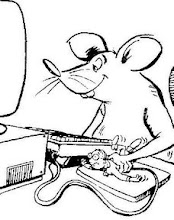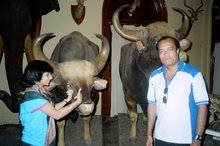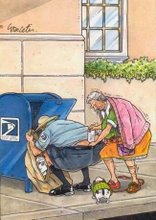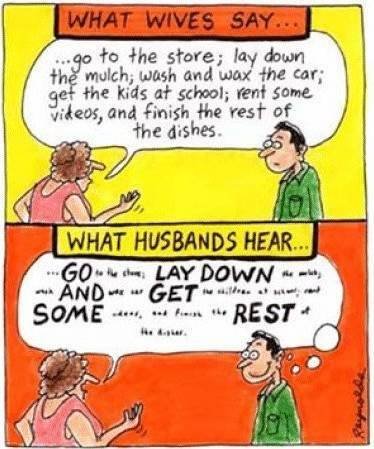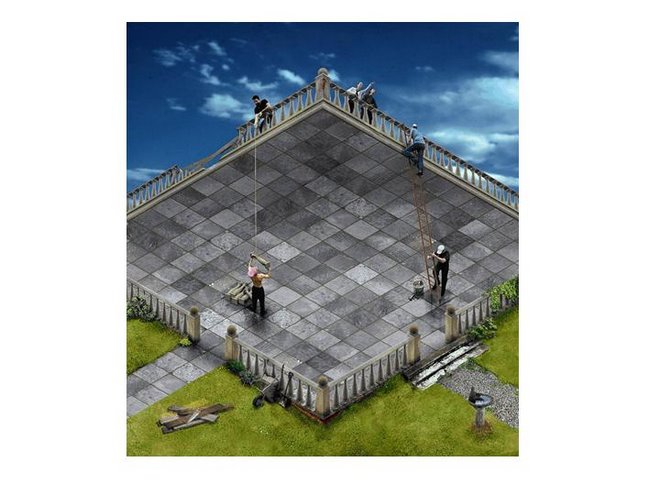A Finnish squirrel with a sweet tooth heads to a Finnish grocery shop at least twice a day to steal "Kinder Surprise" chocolate-shelled eggs.
The manager of the store in Jyvaskyla, central Finland, has named it the Kinder-squirrel, after the treats. It always goes after them, other sweets do not seem to interest it as much. The confectionary, which is intended for children, has a toy inside. It removes the foil carefully, eats the chocolate and leaves the store with the toy.
Unfortunately, the bushy-tailed thief does not clean up after itself, but leaves the wrappers behind.
Saturday, August 4, 2007
Friday, August 3, 2007
Thursday, August 2, 2007
Cellphones light up operating room
The light from the cellphone screens allowed surgeons to complete an emergency appendix operation during a blackout in a city in central Argentina on July 21.
Leonardo Molina, 29, was on the operating table on July 21, when the power went out in the Policlinico Juan D Peron, the main hospital in Villa Mercedes, a small city in San Luis province.
"The generator, which should have been working correctly, didn't work," a hospital spokesman, whose name was not given, told TN television news station. "The surgeons and anesthetists were in the dark. A family member got some cellphones together from people in the hallway and took them in to provide light," he said.
Ricardo Molina, 39, Leonardo's brother, told La Nacion newspaper that the lights were out for an hour and his brother's anesthesia was wearing off.
Leonardo Molina, 29, was on the operating table on July 21, when the power went out in the Policlinico Juan D Peron, the main hospital in Villa Mercedes, a small city in San Luis province.
"The generator, which should have been working correctly, didn't work," a hospital spokesman, whose name was not given, told TN television news station. "The surgeons and anesthetists were in the dark. A family member got some cellphones together from people in the hallway and took them in to provide light," he said.
Ricardo Molina, 39, Leonardo's brother, told La Nacion newspaper that the lights were out for an hour and his brother's anesthesia was wearing off.
Wednesday, August 1, 2007
Railroads America - Strange Experiences
 The builders of the western railroads in the United States had many adventures with the Indians and travellers over the completed lines not infrequently saw redmen making hostile demonstration against the locomotives that crossed the buffalo country and made it increasingly difficult for the hunters to bring in meat.
The builders of the western railroads in the United States had many adventures with the Indians and travellers over the completed lines not infrequently saw redmen making hostile demonstration against the locomotives that crossed the buffalo country and made it increasingly difficult for the hunters to bring in meat.The Central Pacific, invading the territory of the Paiutes and Shoshones, had fewer conflicts with the Indians than the Union Pacific, which built in the lands of the more warlike Sioux and Cheyennes. The Central made treaties with the redmen. As Collis P. Hunting-ton, the Vice-President, put it : "We gave the old chief a pass, good on passenger cars, and we told our men to let the common Indians ride on the freight cars whenever they saw fit." The Paiutes and Shoshones enjoyed these novel experiences and helped instead of hindering the running of the trains.
The Apaches of the southwest, although hostile to the surveyors and graders, made terms with the Southern Pacific when the road was built. It was the Indians of the plains, Sioux and Cheyennes, that took to the war-path against the locomotive.
The Union Pacific in Nebraska and Wyoming was built inside picket lines. "Every mile had to be run within range of the musket," said Chief Engineer Dodge. "In making the surveys numbers of our men, some of them the ablest and most promising, were killed; and during the construction our stock was run off by the hundred, I might say by the thousand; our cars and ranches burned. Graders and track-layers, tie-men and station-builders, had to sleep under guard, and have gone to their work with their picks and shovels and their mechanical tools in one hand and the rifle in the other, and they often had to drop one and use the other."
In 1867 the Indians of the northern plains banded together against the railroad. In the spring the Sioux attacked a surveying party near where the city of Cheyenne now stands, killed the leader, and drove off the others. On July twenty-third a band of three hundred Sioux swooped down upon another party working across the Red Desert, wounded the engineer in charge and stampeded the horses; the surveyors were barely able to escape to the neighboring station of the Overland Stage.
The following month Cheyennes made a sortie against the tracks near Plum Creek, some 230 miles from Omaha. The road was unguarded, and the Indians, making use of a telegraph wire, fastened a wooden tie to the rails. William Thompson, head lineman, with a repair gang of five, was sent from Plum Creek on a hand-car to see what had caused the telegraph break.
The Indians, wondering what would happen on the impeded track, sat around a campfire. The repair crew saw the fire, then saw the Indians, then jumped from the hand-car. The car struck the tie on the rails and was catapulted down a ravine. The white men went sprawling in every direction; one of the Cheyennes caught Thompson, shot him through the arm and tore off his scalp.
The Indians were delighted with their little experiment and now pried up a pair of rails, bent them, and piled more ties across the track. Presently a freight train came along, running at twenty-five miles an hour. The engine hit the barricade and leaped from the track, pulling with it the tender and five cars. Two of these cars were thrown clear over the locomotive, the others piled up on the engine and at once caught fire.
The Indians yelled with satisfaction and shot at any of the trainmen who crawled out from the debris, directing their attention to the wreck in front rather than to the caboose. William Kinney, the conductor of the train, and two others, were able to slip from the caboose unnoticed in the darkness. Another freight train was due from Plum Creek and must be flagged before it struck the wreck.
Charles Ratcliffe, a trainman, was hiding under the caboose when he saw an Indian approaching and, jumping up, dashed for safety. In front he saw the headlight of the second freight, a mile away. Over his shoulder he caught a glimpse of two Indians in pursuit. The conductor and his two companions were almost up with the approaching locomotive. Ratcliffe heard the engine whistle, signalling for the brakes. Would the train back away and leave him The Indians were on his heels. He shouted. The engineer heard him and waited. The Indians were daunted by the headlight, and Ratcliffe reached the locomotive and was pulled aboard. Back to Plum Creek steamed the second freight.
Word was telegraphed to Omaha. The people at Plum Creek, fearing an Indian raid, piled into the freight train to seek refuge at Elm Creek, eighteen miles to the east. Meantime the Indians plundered the wrecked train, set fire to all the cars, and danced around the blaze.
Thompson, the scalped lineman, managed to get to safety at the station of Willow Island to the west. The people of Plum Creek returned in the morning. By nightfall the Indians were riding away, with plenty of loot and a number of scalps.
The next year the Sioux wrecked a train between Alkali and Ogalalla in Nebraska, but the trainmen and passengers were able to stand the Indians off until a relief train arrived. In several instances Indians, planning an attack on the rails, were frightened away by the rush of the locomotive, running at full speed. Stations were surrounded, however, and horses and mules driven off ; and for a considerable time passengers on the Union Pacific, as well as the traincrews, went armed against surprise sorties of the Indians of the plains.
Locomotives have met with many strange adventures in the prairie and mountain country. Prairie and forest fires have swept across the tracks with the roar of a tornado. Trains have succeeded in running the gauntlet with full steam on and wetted roofs, but engineers are chary of plunging into such barriers of flame.
At Kiowa, Kansas, in 1878 a locomotive was swept from a railroad embankment by a water-spout and lost in a quicksand. In 1880 a thunder-storm and water-spout passed over the town of Monotony on the Kansas Pacific Railroad, washed away more than 6000 feet of track and covered the prairie with eight feet of water. An entire freight train vanished, being presumably engulfed in a land-slip. Snow has frequently blocked traffic on the western roads. In December, 1872, several Union Pacific trains, with 350 passengers, were snow-bound for two weeks between Percy and Cheyenne. Railroad officials were able to get food to the stranded cars, and the passengers made their way to a small station where they entertained themselves dancing in the back room of a grocery store to the music of a guitar, a mouth harmonicon and a fine-tooth comb.
In the winter of 1880 a train that had left Penn's Grove on the Delaware River Railroad bound for Woodbury, New Jersey, ran into snow-drifts which were said to be as high as the locomotive's smoke-stack. The engineer tried to push ahead, but his supply of coal ran low. The conductor telegraphed word of his dilemma to the president of the road, who sent back reply : "Use all the fence-rails you can lay your hands on, if your coal gives out. Throw in a barn or two, if necessary. If that fails, take all the pork offered at six dollars per hundred. Keep your steam up, and come through at any cost."
These orders were obeyed, and the train got to Woodbury late that night. As the road had been ploughed open it was decided to try to keep it so, and the train started back at midnight. Two hours later it stuck in a drift. The telegraph wires were down, and the conductor sent a messenger with a request for another engine. The second engine was sent out, but it also was stalled in the snow. Train and relief-engine were lost sight of for many hours, and were finally discovered by sleighs that hunted for them through the great drifts.
Tuesday, July 31, 2007
Man survives lightning strike, again!
Lightning can strike twice. Just ask American Don Frick, a resident of Hamlin.
Frick said he survived his second lightning strike on Friday, July 27th - 27 years to the day of his first - and emerged a bit shaken, with only a burned zipper and a hole in the back of his jeans. "I'm lucky I'm alive," Frick said in a phone interview two days later.
Frick was attending a festival when a storm came up quickly. He and six others sought refuge in a shed shortly before lightning struck the ground nearby. The strike sent a shock through Frick and four others.
"It put me up against the wall," said Frick, 68. "When I came to and realized I was alive, the first thing that came to my mind was that I'm pretty lucky."
None of the others were seriously injured.
Twenty-seven years earlier, Frick said he was driving a tractor-trailer when the antenna was struck by lightning, injuring his left side for weeks.
Frick said he survived his second lightning strike on Friday, July 27th - 27 years to the day of his first - and emerged a bit shaken, with only a burned zipper and a hole in the back of his jeans. "I'm lucky I'm alive," Frick said in a phone interview two days later.
Frick was attending a festival when a storm came up quickly. He and six others sought refuge in a shed shortly before lightning struck the ground nearby. The strike sent a shock through Frick and four others.
"It put me up against the wall," said Frick, 68. "When I came to and realized I was alive, the first thing that came to my mind was that I'm pretty lucky."
None of the others were seriously injured.
Twenty-seven years earlier, Frick said he was driving a tractor-trailer when the antenna was struck by lightning, injuring his left side for weeks.
Monday, July 30, 2007
Subscribe to:
Comments (Atom)



